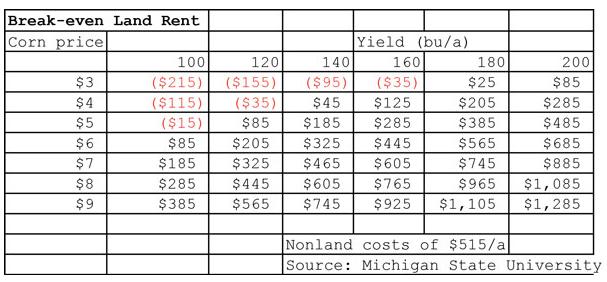Here's help in deciding how much rent you can afford for land.
We've all heard the stories about land rents gone wild:$400/acre.$500.Even$550.
Corn and soybean growers have been bidding those rents up,hoping to spread their fixed costs of machinery ownership over more acres.
But does it make sense to get in the bidding war if you're dairy farmer hoping to hedge feed prices?That's the$400 or$500/acre question,says Chris Wolf,a farm management specialist with the Michigan State University.
In the past,it was cheaper to buy corn and even corn silage.For example,farm records from Michigan 10 years ago show it cost of about$2.90/bu.to raise corn and$30/ton to raise corn silage.That didn't make a lot of sense when you could buy corn for less than$2/bu.and silage for$25/ton.
The only crop that made economic sense to raise was alfalfa hay.Growing costs were about$95/ton.But good quality dairy hay was already at$100/ton or more.
Fast forward a decade to 2013 feed prices.If you have to shell out$7/bu.for corn,raising that corn on rented acres might make sense.It all depends on the yield potential of the ground you're renting and the rental rate you can negotiate.
University of Illinois farm records show that non-land costs for raising corn exceed$500/acre.That includes seed,fertilizer,pesticides,dry storage,crop insurance,machinery,fuel and oil,depreciation,labor and interest.
In 2012,those non-land costs totaled$520/acre for ground with a yield potential of 175 to 195 bu./acre.The projected costs for 2013 are similar,says Wolf.
"You can calculate your break-even land rent across corn price and corn yields given non-land costs of$515/acre,"says Wolf.Even better,use your own projected costs,he says.
The maximum rent you can afford to pay is a fairly straight forward formula:
Maximum rent=(Yield X Feed cost($/bu.)–non-land feed costs($/acre).
At$5/bu.corn and 160 bu./acre corn yield,the maximum rent you can afford to pay with this formula is$285/acre.But at$7/corn,the maximum rent jumps to$605/acre.
If the potential of the land is 200 bu./acre,$5/bu.corn shows a maximum land rent of$485/acre.And$7/bu.corn jumps the maximum to$885/acre.
Obviously,that doesn't mean you should pay that amount,says Wolf.But it does show you how much you can pay and breakeven.
On the other hand,the chart shows that if you can lock up an acre of land for$300/acre and it has a yield potential of 160/acre,you're locking in about$5/bu.corn cost.
It's really another form of risk management,says Wolf.You could lock in the$5/bu.corn through forward pricing or a futures contract.But if you have the machinery,storage and labor to grow corn,it's another way to more fully utilize those assets,he says.
The tool might be particularly helpful if you must rent additional ground for corn silage.Growing your own silage often allows you to better control hybrid selection and harvest management.
Flexible land leases are also an option."With extreme volatility in commodity price,if farmers have a flexible lease they can pay more in rent when the corn price is over$5/bu.and less when it's below$4,"says Wolf.
"Then the landowner doesn't feel like he is being taken advantage of whe they see corn selling for$7/bu.and the rent is$180/acre,"he says.




